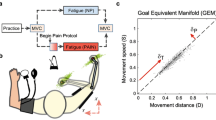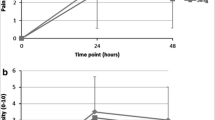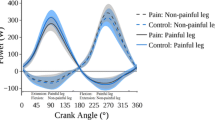Abstract
Pain elicits complex adaptations of motor strategy, leading to impairments in the generation and control of steady forces, which depend on muscle architecture. The present study used a cross-over design to assess the effects of muscle pain on the stability of multidirectional (task-related and tangential) forces during sustained dorsiflexions, elbow flexions, knee extensions, and plantarflexions. Fifteen healthy subjects performed series of isometric contractions (13-s duration, 2.5, 20, 50, 70% of maximal voluntary force) before, during, and after experimental muscle pain. Three-dimensional force magnitude, angle and variability were measured while the task-related force was provided as feedback to the subjects. Surface electromyography was recorded from agonist and antagonist muscles. Pain was induced in agonist muscles by intramuscular injections of hypertonic (6%) saline with isotonic (0.9%) saline injections as control. The pain intensity was assessed on an electronic visual analogue scale. Experimental muscle pain elicited larger ranges of force angle during knee extensions and plantarflexions (P < 0.03) and higher normalized fluctuations of task-related (P < 0.02) and tangential forces (P < 0.03) compared with control assessments across force levels, while the mean force magnitudes, mean force angle and the level of muscle activity were non-significantly affected by pain. Increased multidirectional force fluctuations probably resulted from multiple mechanisms that, acting together, balanced the mean surface electromyography. Although pain adaptations are believed to aim at the protection of the painful site, the current results show that they result in impairments in steadiness of force.






Similar content being viewed by others
References
Bandholm T, Rasmussen L, Aagaard P, Jensen BR, Diederichsen L (2006) Force steadiness, muscle activity, and maximal muscle strength in subjects with subacromial impingement syndrome. Muscle Nerve 34:631–639
Bandholm T, Rasmussen L, Aagaard P, Diederichsen L, Jensen BR (2008) Effects of experimental muscle pain on shoulder-abduction force steadiness and muscle activity in healthy subjects. Eur J Appl Physiol 102:643–650
Birch L, Christensen H, Arendt-Nielsen L, Graven-Nielsen T, Søgaard K (2000) The influence of experimental muscle pain on motor unit activity during low-level contraction. Eur J Appl Physiol 83:200–206
Carville SF, Perry MC, Rutherford OM, Smith ICH, Newham DJ (2007) Steadiness of quadriceps contractions in young and older adults with and without a history of falling. Eur J Appl Physiol 100:527–533
Del Santo F, Gelli F, Spidalieri R, Rossi A (2007) Corticospinal drive during painful voluntary contractions at constant force output. Brain Res 1128:91–98
Ervilha UF, Arendt-Nielsen L, Duarte M, Graven-Nielsen T (2004) Effect of load level and muscle pain intensity on the motor control of elbow-flexion movements. Eur J Appl Physiol 92:168–175
Ervilha UF, Farina D, Arendt-Nielsen L, Graven-Nielsen T (2005) Experimental muscle pain changes motor control strategies in dynamic contractions. Exp Brain Res 164:215–224
Falla D, Farina D, Graven-Nielsen T (2007) Experimental muscle pain results in reorganization of coordination among trapezius muscle subdivisions during repetitive shoulder flexion. Exp Brain Res 178:385–393
Farina D, Arendt-Nielsen L, Merletti R, Graven-Nielsen T (2004) Effect of experimental muscle pain on motor unit firing rate and conduction velocity. J Neurophysiol 91:1250–1259
Fuglevand AJ, Winter DA, Patla AE (1993) Models of recruitment and rate coding organization in motor-unit pools. J Neurophysiol 70:2470–2488
Graven-Nielsen T (2006) Fundamentals of muscle pain, referred pain, and deep tissue hyperalgesia. Scand J Rheumatol 35:1–43
Graven-Nielsen T, Svensson P, Arendt-Nielsen L (1997) Effects of experimental muscle pain on muscle activity and co-ordination during static and dynamic motor function. Electroencephalogr Clin Neurophysiol 105:156–164
Graven-Nielsen T, Lund H, Arendt-Nielsen L, Danneskiold Samsøe B, Bliddal H (2002) Inhibition of maximal voluntary contraction force by experimental muscle pain: a centrally mediated mechanism. Muscle Nerve 26:708–712
Henneman E, Somjen G, Carpenter DO (1965) Functional significance of cell size in spinal motoneurons. J Neurophysiol 28:560–580
Hermens HJ, Freriks B, Disselhorst-Klug C, Rau G (2000) Development of recommendations for SEMG sensors and sensor placement procedures. J Electromyogr Kinesiol 10:361–374
Herrmann U, Flanders M (1998) Directional tuning of single motor units. J Neurosci Methods 18:8402–8416
Hodges PW, Tucker K (2011) Moving differently in pain: a new theory to explain the adaptation to pain. Pain 152:S90–S98
Hodges PW, Ervilha UF, Graven-Nielsen T (2008) Changes in motor unit firing rate in synergist muscles cannot explain the maintenance of force during constant force painful contractions. J Pain 9:1169–1174
Hong SL, Lee MH, Newell KM (2007) Magnitude and structure of isometric force variability: mechanical and neurophysiological influences. Mot Control 11:119–135
Hortobágyi T, Garry J, Holbert D, Devita P (2004) Aberrations in the control of quadriceps muscle force in patients with knee osteoarthritis. Arthritis Rheum 51:562–569
Jones KE, Hamilton AFC, Wolpert DM (2002) Sources of signal-dependent noise during isometric force production. J Neurophysiol 88:1533–1544
Kumazawa T, Mizumura K (1977) Thin-fibre receptors responding to mechanical, chemical, and thermal stimulation in the skeletal muscle of the dog. J Physiol 273:179–194
Kutch JJ, Kuo AD, Bloch AM, Rymer WZ (2008) Endpoint force fluctuations reveal flexible rather than synergistic patterns of muscle cooperation. J Neurophysiol 100:2455–2471
Lavender AP, Nosaka K (2006) Changes in fluctuation of isometric force following eccentric and concentric exercise of the elbow flexors. Eur J Appl Physiol 96:235–240
Lund JP, Donga R, Widmer CG, Stohler CS (1991) The pain-adaptation model: a discussion of the relationship between chronic musculoskeletal pain and motor activity. Can J Physiol Pharm 69:683–694
Madeleine P (2010) On functional motor adaptations: from the quantification of motor strategies to the prevention of musculoskeletal disorders in the neck-shoulder region. Acta Physiol 199:1–46
Madeleine P, Leclerc F, Arendt-Nielsen L, Ravier P, Farina D (2006) Experimental muscle pain changes the spatial distribution of upper trapezius muscle activity during sustained contraction. Clin Neurophysiol 117:2436–2445
Missenard O, Mottet D, Perrey S (2009) Factors responsible for force steadiness impairment with fatigue. Muscle Nerve 40:1019–1032
Moritz CT, Barry BK, Pascoe MA, Enoka RM (2005) Discharge rate variability influences the variation in force fluctuations across the working range of a hand muscle. J Neurophysiol 93:2449–2459
Prieto TE, Myklebust JB, Hoffmann RG, Lovett EG, Myklebust BM (1996) Measures of postural steadiness: differences between healthy young and elderly adults. IEEE Trans Biomed Eng 43:956–966
Salomoni SE, Graven-Nielsen T (2012) Muscle fatigue increases the amplitude of fluctuations of tangential forces during isometric contractions. Hum Mov Sci (in press). http://dx.doi.org/10.1016/j.humov.2011.08.012
Schomburg ED, Steffens H, Kniffki KD (1999) Contribution of group III and IV muscle afferents to multisensorial spinal motor control in cats. Neurosci Res 33:195–206
Semmler JG, Tucker KJ, Allen TJ, Proske U (2007) Eccentric exercise increases EMG amplitude and force fluctuations during submaximal contractions of elbow flexor muscles. J Appl Physiol 103:979–989
Shinohara M, Moritz CT, Pascoe MA, Enoka RM (2005) Prolonged muscle vibration increases stretch reflex amplitude, motor unit discharge rate, and force fluctuations in a hand muscle. J Appl Physiol 99:1835–1842
Staudenmann D, Kingma I, Daffertshofer A, Stegeman DF, van Dieën JH (2009) Heterogeneity of muscle activation in relation to force direction: a multi-channel surface electromyography study on the triceps surae muscle. J Electromyogr Kinesiol 19:882–895
Stein RB, Gossen ER, Jones KE (2005) Neuronal variability: noise or part of the signal? Nat Rev Neurosci 6:389–397
Svendsen JH, Madeleine P (2010) Amount and structure of force variability during short, ramp and sustained contractions in males and females. Hum Mov Sci 29:35–47
Taylor AM, Christou EA, Enoka RM (2003) Multiple features of motor-unit activity influence force fluctuations during isometric contractions. J Neurophysiol 90:1350–1361
Tracy BL (2007) Force control is impaired in the ankle plantarflexors of elderly adults. Eur J Appl Physiol 101:629–636
Tracy BL, Mehoudar PD, Ortega JD (2007) The amplitude of force variability is correlated in the knee extensor and elbow flexor muscles. Exp Brain Res 176:448–464
Tucker KJ, Hodges PW (2009) Motoneurone recruitment is altered with pain induced in non-muscular tissue. Pain 141:151–155
Tucker KJ, Hodges PW (2010) Changes in motor unit recruitment strategy during pain alters force direction. Eur J Pain 14:932–938
Wessberg J, Vallbo AB (1995) Coding of pulsatile motor output by human muscle afferents during slow finger movements. J Physiol 485:271–282
Yao W, Fuglevand RJ, Enoka RM (2000) Motor-unit synchronization increases EMG amplitude and decreases force steadiness of simulated contractions. J Neurophysiol 83:441–452
Yoshitake Y, Shinohara M, Kouzaki M, Fukunaga T (2004) Fluctuations in plantar flexion force are reduced after prolonged tendon vibration. J Appl Physiol 97:2090–2097
Yoshitake Y, Masani K, Shinohara M (2008) Laser-detected lateral muscle displacement is correlated with force fluctuations during voluntary contractions in humans. J Neurosci Methods 173:271–278
Zhang W, Gordon AM, Fu Q, Santello M (2010) Manipulation after object rotation reveals independent sensorimotor memory representations of digit positions and forces. J Neurophysiol 103:2953–2964
Zhang W, Gordon AM, McIsaac TL, Santello M (2011) Within-trial modulation of multi-digit forces to friction. Exp Brain Res 211:17–26
Acknowledgments
The study has been financed by Svend Andersen Fonden (Aalborg, Denmark). Dr. Hong-You Ge, Center for Sensory-Motor Interaction (Aalborg University, Denmark), is acknowledged for his help with the experimental procedure.
Conflict of interest
The authors declare that they have no conflict of interest.
Author information
Authors and Affiliations
Corresponding author
Additional information
Communicated by Toshio Moritani.
Rights and permissions
About this article
Cite this article
Salomoni, S.E., Graven-Nielsen, T. Experimental muscle pain increases normalized variability of multidirectional forces during isometric contractions. Eur J Appl Physiol 112, 3607–3617 (2012). https://doi.org/10.1007/s00421-012-2343-7
Received:
Accepted:
Published:
Issue Date:
DOI: https://doi.org/10.1007/s00421-012-2343-7




